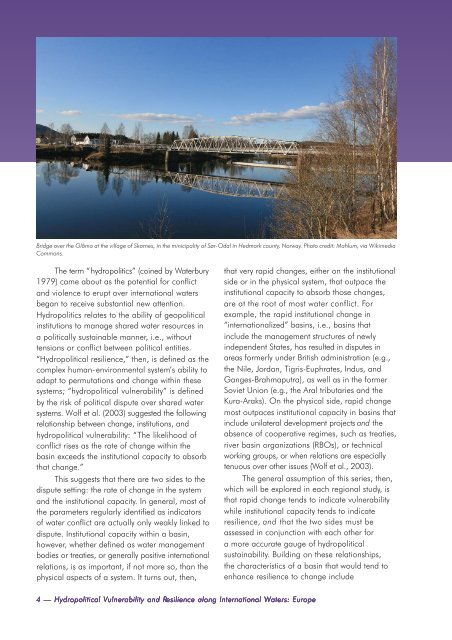Europe - UNEP
Europe - UNEP
Europe - UNEP
You also want an ePaper? Increase the reach of your titles
YUMPU automatically turns print PDFs into web optimized ePapers that Google loves.
Bridge over the Glåma at the village of Skarnes, in the minicipality of Sør-Odal in Hedmark county, Norway. Photo credit: Mahlum, via Wikimedia<br />
Commons.<br />
The term “hydropolitics” (coined by Waterbury<br />
1979) came about as the potential for conflict<br />
and violence to erupt over international waters<br />
began to receive substantial new attention.<br />
Hydropolitics relates to the ability of geopolitical<br />
institutions to manage shared water resources in<br />
a politically sustainable manner, i.e., without<br />
tensions or conflict between political entities.<br />
“Hydropolitical resilience,” then, is defined as the<br />
complex human-environmental system’s ability to<br />
adapt to permutations and change within these<br />
systems; “hydropolitical vulnerability” is defined<br />
by the risk of political dispute over shared water<br />
systems. Wolf et al. (2003) suggested the following<br />
relationship between change, institutions, and<br />
hydropolitical vulnerability: “The likelihood of<br />
conflict rises as the rate of change within the<br />
basin exceeds the institutional capacity to absorb<br />
that change.”<br />
This suggests that there are two sides to the<br />
dispute setting: the rate of change in the system<br />
and the institutional capacity. In general, most of<br />
the parameters regularly identified as indicators<br />
of water conflict are actually only weakly linked to<br />
dispute. Institutional capacity within a basin,<br />
however, whether defined as water management<br />
bodies or treaties, or generally positive international<br />
relations, is as important, if not more so, than the<br />
physical aspects of a system. It turns out, then,<br />
that very rapid changes, either on the institutional<br />
side or in the physical system, that outpace the<br />
institutional capacity to absorb those changes,<br />
are at the root of most water conflict. For<br />
example, the rapid institutional change in<br />
“internationalized” basins, i.e., basins that<br />
include the management structures of newly<br />
independent States, has resulted in disputes in<br />
areas formerly under British administration (e.g.,<br />
the Nile, Jordan, Tigris-Euphrates, Indus, and<br />
Ganges-Brahmaputra), as well as in the former<br />
Soviet Union (e.g., the Aral tributaries and the<br />
Kura-Araks). On the physical side, rapid change<br />
most outpaces institutional capacity in basins that<br />
include unilateral development projects and the<br />
absence of cooperative regimes, such as treaties,<br />
river basin organizations (RBOs), or technical<br />
working groups, or when relations are especially<br />
tenuous over other issues (Wolf et al., 2003).<br />
The general assumption of this series, then,<br />
which will be explored in each regional study, is<br />
that rapid change tends to indicate vulnerability<br />
while institutional capacity tends to indicate<br />
resilience, and that the two sides must be<br />
assessed in conjunction with each other for<br />
a more accurate gauge of hydropolitical<br />
sustainability. Building on these relationships,<br />
the characteristics of a basin that would tend to<br />
enhance resilience to change include<br />
4 — Hydropolitical Vulnerability and Resilience along International Waters: <strong>Europe</strong>
















